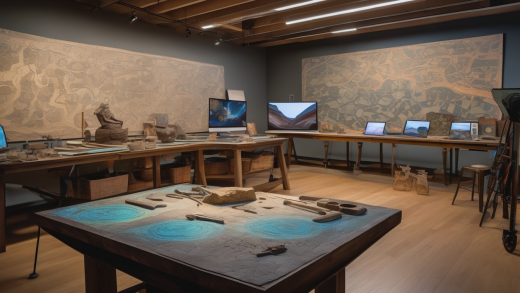In the fast-paced world of artificial intelligence, negotiating project deadlines can feel like walking a tightrope. On one side, you have the pressure to deliver quickly, and on the other, the necessity to maintain quality. So, how do you strike that perfect balance? The key lies in understanding both your client’s expectations and the intricacies of the project at hand.
First and foremost, it’s essential to engage in open communication with your clients. Ask them about their priorities and what success looks like for them. Are they more concerned about speed, or do they value thoroughness? By gathering insights into their needs, you can align your timeline with their expectations, ensuring that both parties are on the same page. This approach not only helps in setting realistic deadlines but also builds trust, which is vital for a successful partnership.
Next, assess the complexity of the AI project. Not all projects are created equal; some may involve advanced machine learning algorithms, while others might be straightforward data processing tasks. Understanding the nuances of your project will allow you to set more achievable deadlines. For instance, a project that requires extensive data cleaning and preparation will naturally take longer than one that doesn’t. By recognizing these complexities, you can better manage client expectations and avoid any last-minute surprises.
Establishing key milestones is another effective strategy for keeping both your team and your clients informed. By breaking down the project into manageable phases, you can track progress and celebrate small wins along the way. This not only keeps everyone motivated but also gives clients a sense of involvement in the process. Consider creating a timeline that highlights these milestones, making it visually clear when each phase is expected to be completed.
When it comes to setting timeframes, remember that accuracy is critical. Use your understanding of the project’s complexity, combined with your team’s capacity, to estimate time requirements realistically. Avoid the temptation to promise quick turnarounds just to please the client; instead, present a well-thought-out schedule that prioritizes quality while still being mindful of deadlines.
In summary, negotiating AI project deadlines is not just about speed; it’s about fostering a collaborative environment where quality is never compromised. By understanding client expectations, assessing project complexities, and maintaining open lines of communication, you can create a roadmap that satisfies everyone involved. So, the next time you’re faced with a tight deadline, remember that with the right strategies, you can deliver excellence while keeping your clients happy.

Understanding Client Expectations
When it comes to negotiating deadlines for AI projects, the first step is to truly understand client expectations. This isn’t just about asking a few questions; it’s about diving deep into what the client envisions. Think of it like preparing for a big date—you wouldn’t just show up without knowing what your partner likes, right? Similarly, knowing your client’s priorities, project scope, and desired outcomes can set the stage for a successful collaboration.
Start by engaging in open conversations with your clients. Ask them about their ultimate goals for the project. What are their top priorities? Are they looking for speed, or is quality their main concern? Understanding these nuances can help you align your timeline with their needs. You might even consider using a structured approach to gather insights. For instance, you can create a simple table to summarize their expectations:
| Expectation | Client’s Priority |
|---|---|
| Project Scope | High |
| Quality of Deliverables | Very High |
| Timeline Flexibility | Medium |
Don’t forget to ask about any specific requirements or constraints they might have. This can include budget limitations, compliance issues, or even preferences for certain technologies. By thoroughly understanding these factors, you can avoid potential roadblocks down the line and set realistic deadlines that satisfy both parties.
Lastly, keep in mind that communication is key. Regular check-ins can help ensure that both you and your client remain on the same page throughout the project lifecycle. So, don’t hesitate to ask questions and clarify expectations as you go. After all, a well-informed project is a successful project!

Assessing Project Complexity
When it comes to AI projects, understanding the complexity is not just a checkbox on your project management list; it’s the very foundation upon which you build your timeline. Every project has its unique challenges, and recognizing these intricacies can make or break your deadline negotiations. So, how do you get a grip on the complexity of a project?
First, you need to dive deep into the technical requirements. Are there advanced algorithms involved? Is the data set large and unwieldy? These factors can significantly affect the time it takes to deliver a quality product. Additionally, consider the stakeholders involved. The more people you have weighing in, the more complex the communication and approval processes become. This leads us to the importance of mapping out all project components, which can be done using a simple table:
| Project Component | Complexity Level | Impact on Timeline |
|---|---|---|
| Data Collection | High | +2 weeks |
| Algorithm Development | Medium | +1 week |
| Testing & Validation | High | +3 weeks |
Next, consider the team’s expertise. Are your team members seasoned veterans in AI, or are they still finding their footing? A skilled team can navigate complex projects more efficiently, while a less experienced team might require additional time for learning and adaptation. This is where team dynamics come into play. Building a cohesive unit can help mitigate some of the complexities, but it takes time to develop.
Lastly, don’t forget about external factors that can influence project complexity. Market dynamics, client expectations, and even regulatory requirements can add layers of complexity that must be addressed. By thoroughly assessing these elements, you can set more realistic deadlines that align with both quality and speed, ensuring a smoother negotiation process with your clients.
Identifying Key Milestones
When it comes to managing AI projects, is like laying down the stepping stones on a path to success. These milestones serve as crucial checkpoints that help you measure progress and keep the project on track. Think of them as the GPS coordinates guiding you through the often complex terrain of AI development. By breaking the project down into manageable phases, you not only create a clearer roadmap but also enhance communication with your client.
To effectively identify these milestones, start by outlining the major components of the project. This can include stages such as research and development, testing, and deployment. Each of these stages can be further divided into smaller tasks, making it easier to track progress and manage expectations. For instance:
- Research Phase: Conducting literature reviews, gathering data, and defining project scope.
- Development Phase: Building algorithms, coding, and initial testing.
- Testing Phase: User acceptance testing, performance evaluations, and adjustments.
- Deployment Phase: Launching the AI solution and monitoring initial performance.
By establishing these key milestones, you create a framework that facilitates regular updates and discussions with your client. Each milestone reached can serve as a moment to celebrate progress, address any concerns, and recalibrate expectations if necessary. This not only fosters a sense of teamwork but also builds trust, as clients see their project moving forward in a structured manner.
Moreover, incorporating visual tools like Gantt charts or Kanban boards can help both you and your client visualize the timeline and the interdependencies between tasks. These tools allow for quick adjustments and real-time updates, ensuring that everyone remains aligned throughout the project lifecycle. In summary, identifying key milestones is not just about tracking progress; it’s about creating a collaborative environment where speed and quality coexist harmoniously.
Setting Realistic Timeframes
When it comes to for AI projects, it’s all about finding that sweet spot between speed and quality. You might be eager to impress your clients with rapid delivery, but rushing can lead to mistakes that cost more time in the long run. So, how do you strike a balance? First off, consider the project’s complexity. Each project will have its own unique challenges, and understanding these can help you set more accurate deadlines.
One effective strategy is to break the project down into smaller, manageable tasks. This way, you can estimate the time required for each phase and create a more comprehensive timeline. For instance, if you’re working on an AI model, you might divide the project into stages such as research, development, testing, and deployment. By doing so, you can provide your clients with a clearer picture of what to expect at each step.
Additionally, it’s essential to involve your team in the planning process. After all, they are the ones who will be executing the tasks. Having a team meeting to gather input on time estimates can lead to more accurate projections. You could even create a simple table to visualize the timeline:
| Project Phase | Estimated Timeframe |
|---|---|
| Research | 2 Weeks |
| Development | 4 Weeks |
| Testing | 2 Weeks |
| Deployment | 1 Week |
Lastly, always build in some buffer time for unexpected challenges. It’s like planning a road trip; you wouldn’t just account for driving time without considering traffic or detours. By allowing for some flexibility, you can ensure that you meet the deadline without sacrificing the quality of your work. Remember, it’s better to under-promise and over-deliver than to rush and fall short!
Communicating Progress Effectively
When it comes to managing AI projects, effective communication is the golden key that unlocks success. Keeping your clients in the loop not only builds trust but also ensures that everyone is on the same page. Think of it like a dance; both partners need to know the steps to avoid stepping on each other’s toes. So, how do you make sure your clients are well-informed about the project’s progress?
First and foremost, establish a routine for updates. Whether it’s weekly emails or bi-weekly video calls, consistency is crucial. Clients should know when to expect updates, and you should deliver them like clockwork. This not only keeps them informed but also helps manage their expectations. For instance, you might say, “I’ll provide a detailed update every Friday,” to set a clear timeline.
In addition to regular updates, consider using visual aids to enhance understanding. Graphs, charts, and progress dashboards can be incredibly effective in illustrating where the project stands. They transform complex data into digestible information, making it easier for clients to grasp the current status. For example, a simple table could outline key milestones and their completion status, like this:
| Milestone | Completion Date | Status |
|---|---|---|
| Initial Research | 01/15/2023 | Completed |
| Prototype Development | 02/20/2023 | In Progress |
| Client Review | 03/01/2023 | Upcoming |
Moreover, be proactive in addressing any concerns. If you foresee a potential delay, communicate this early on. Clients appreciate transparency, and it shows that you are committed to maintaining quality. A simple message like, “We encountered a minor challenge, but we’re on it and will keep you updated,” can go a long way in fostering a positive relationship.
Lastly, don’t forget to celebrate milestones! Acknowledging achievements, no matter how small, can boost morale and strengthen your partnership. A quick email or a shout-out during a meeting can make your clients feel valued and engaged in the process. Remember, effective communication is not just about relaying information; it’s about building a relationship that thrives on trust and collaboration.
Incorporating Feedback Loops
Incorporating feedback loops into your AI project is like adding a secret ingredient to your favorite recipe—it enhances the flavor and ensures a satisfying outcome. Regularly soliciting client input at various stages of the project not only promotes a sense of collaboration but also allows for necessary adjustments without compromising on quality or speed. Think of it as a dance; both you and your client need to be in sync to create a masterpiece.
To effectively implement feedback loops, start by establishing clear checkpoints throughout the project timeline. These checkpoints serve as moments to pause, reflect, and gather insights from your client. For instance, after completing a significant phase, you can present the outcomes and ask for their thoughts. This not only keeps the client engaged but also helps in identifying any misalignments early on.
Moreover, consider using various methods to collect feedback. Whether it’s through structured surveys, informal chats, or collaborative tools, having multiple avenues for feedback can cater to different client preferences. Here are some effective strategies:
- Surveys: Use short, focused surveys to gauge satisfaction and gather specific insights.
- Regular Meetings: Schedule weekly or bi-weekly check-ins to discuss progress and gather real-time feedback.
- Collaborative Tools: Platforms like Trello or Asana can facilitate ongoing discussions and feedback directly on project tasks.
Finally, it’s essential to communicate how client feedback has been integrated into the project. This not only shows that you value their input but also reinforces trust and strengthens your working relationship. By weaving feedback loops into your project management process, you create a dynamic environment where speed and quality coexist harmoniously, ultimately leading to a successful project delivery.

Leveraging Technology for Efficiency
In today’s fast-paced world, leveraging technology is not just a luxury; it’s a necessity for enhancing efficiency in AI project management. By integrating the right tools and platforms, you can streamline processes and create a smoother workflow that benefits both your team and your clients. But how do you choose the right technology? It’s all about understanding your project’s specific needs and the tools available in the market.
One of the most effective ways to boost efficiency is through automation. Automation tools can handle repetitive tasks, allowing your team to focus on more complex aspects of the project. For instance, consider using automated reporting tools that generate updates without manual input. This not only saves time but also reduces the risk of human error, ensuring that your project stays on track. Imagine freeing up hours each week for your team to innovate rather than just manage tasks!
Additionally, project management software plays a pivotal role in keeping everything organized. These platforms allow for real-time tracking of deadlines, resources, and team collaboration. Popular options like Trello, Asana, and Jira offer features that help you visualize project timelines and allocate resources effectively. By using these tools, you can easily identify bottlenecks and adjust your plans accordingly. Here’s a quick comparison of some popular project management tools:
| Tool | Key Features | Best For |
|---|---|---|
| Trello | Visual boards, task assignments, integrations | Small to medium teams |
| Asana | Task tracking, timelines, reporting | Flexible project workflows |
| Jira | Agile project management, bug tracking | Software development teams |
Moreover, communication tools such as Slack and Microsoft Teams can enhance collaboration among team members and clients alike. Regular updates and discussions can happen in real-time, ensuring everyone is on the same page. When clients feel involved and informed, it fosters a sense of trust and partnership, which is invaluable in negotiations.
By leveraging these technologies, you not only improve efficiency but also create a more transparent and collaborative environment. So, why not take the plunge and explore these tools? You might just find that they revolutionize the way you manage your AI projects!
Automation and AI Tools
In today’s fast-paced world, have become essential allies in managing AI projects efficiently. These technologies not only streamline workflows but also enhance the quality of deliverables. Imagine trying to navigate a busy highway without a GPS; it would be chaotic, right? Similarly, without the right tools, project management can feel overwhelming.
One of the primary benefits of incorporating automation into your workflow is the reduction of manual tasks. For instance, consider how automated reporting can save hours of time. Instead of compiling data manually, tools can generate reports in real-time, allowing you to focus on more critical aspects of the project. This leads to quicker decision-making and helps maintain momentum.
Moreover, AI tools can analyze vast amounts of data at lightning speed, providing insights that would take humans days to uncover. This capability is particularly valuable when assessing project complexity and identifying potential bottlenecks. By leveraging these insights, you can make informed adjustments to timelines and expectations, ensuring that quality is never compromised.
Here are a few popular automation and AI tools that can elevate your project management game:
- Zapier: Automates repetitive tasks by connecting different apps.
- Asana: A project management tool that integrates AI to help prioritize tasks.
- Trello: Uses automation to streamline task assignments and updates.
Incorporating these tools not only boosts efficiency but also fosters a collaborative environment. Teams can share updates in real-time, reducing the chances of miscommunication. Ultimately, the right automation and AI tools can transform your project management approach, making it easier to balance speed and quality. So, why not embrace these technologies and take your AI project negotiations to the next level?
Project Management Software
In today’s fast-paced digital landscape, is a game changer for teams working on AI projects. These tools not only help in tracking deadlines but also enhance collaboration and streamline communication. Imagine trying to herd cats without a plan—chaos, right? That’s what managing an AI project without the right software feels like. So, let’s dive into how these platforms can transform your project management experience.
First off, project management software provides a centralized platform where all team members can access project details, timelines, and resources. This centralization is crucial for keeping everyone on the same page and avoiding miscommunication. When everyone knows their responsibilities and deadlines, the entire project runs smoother. Popular tools like Asana, Trello, and Jira offer features like task assignments, progress tracking, and deadline reminders that keep the project moving forward.
Moreover, these tools often come with built-in reporting capabilities. This means you can easily generate reports to assess project health and team performance. For instance, if you’re falling behind on a deadline, you can quickly analyze where the bottleneck is occurring and address it before it spirals out of control. The ability to visualize progress through charts and graphs makes it easier to communicate with clients, showing them that you’re on track or adjusting timelines as necessary.
Another significant advantage is the integration of collaboration tools within project management software. Features like file sharing, comment threads, and real-time updates make it easier to solicit feedback and make adjustments on the fly. This is particularly important in AI projects, where client expectations can shift rapidly. By incorporating feedback loops, you ensure that the final product aligns with the client’s vision without sacrificing quality.
In conclusion, leveraging project management software is essential for anyone looking to negotiate deadlines effectively while maintaining high standards. With the right tools, you can enhance productivity, improve communication, and ultimately deliver successful AI projects that meet or exceed client expectations.
Frequently Asked Questions
- How can I better understand my client’s expectations for an AI project?
Start by asking open-ended questions to gauge their priorities and desired outcomes. Use active listening techniques to clarify their needs and ensure that you’re on the same page. This will help you align your project timeline with their expectations.
- What are effective ways to assess the complexity of an AI project?
Evaluate the project’s requirements by breaking down tasks into manageable components. Consider factors such as data availability, algorithm complexity, and integration needs. This assessment will give you a clearer picture of the time and resources needed.
- How do I establish key milestones in an AI project?
Identify critical phases of the project and set specific, measurable milestones. This could include stages like data collection, model training, and testing. Milestones help track progress and keep both you and your client informed and engaged.
- What tips can I use for setting realistic timeframes?
Analyze past projects for time estimates and consult your team to gauge their capacities. Be honest about potential challenges and buffer your timelines to accommodate unforeseen delays, ensuring quality isn’t compromised.
- How can I communicate project progress effectively?
Schedule regular updates via email or meetings, and use project management tools to share progress visually. Celebrate small wins to keep morale high and ensure your client feels involved and informed throughout the process.
- What role do feedback loops play in AI projects?
Feedback loops are essential for continuous improvement. They allow you to solicit client input at various stages, making it easier to adjust the project as needed without sacrificing quality or speed.
- How can technology improve deadline negotiations?
Utilizing project management software and collaboration tools can streamline communication and task tracking. These technologies help you stay organized, making it easier to negotiate deadlines that are realistic and achievable.
- What are some examples of automation tools for AI projects?
Look into tools like TensorFlow for model training and Zapier for automating repetitive tasks. These can significantly reduce manual work and speed up workflows while maintaining high-quality deliverables.
- Which project management software is best for tracking deadlines?
Popular options include Trello, Asana, and Jira. These tools help you organize tasks, set timelines, and facilitate team collaboration, making your negotiation process smoother and more efficient.


